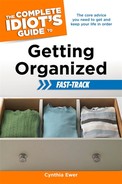When two or more activities share one space, it’s important that each activity be self-contained. Nobody wants to throw a dinner party with the sewing machine taking the place at the head of the table. To craft a workable solution, you need to set up spaces that you can close off when the activity is not in play.
Simple solutions for multiuse spaces include visual dividers such as screens. Give the sewing machine a home on a small corner table, and add a rolling organizer cart to store scissors, pattern pieces, and sewing tools. When not in use, screen the sewing corner from view with a folding shoji screen or ceiling-mounted curtain.
A closet with folding doors can anchor an activity center in a multiuse area as well. To incorporate a mailing center into the guest room, mount a desk-level shelf in the closet to provide workspace for wrapping and addressing packages. Flattened boxes can be stacked and stashed under the bed, while wares to be sent are stored on closet shelves. With the door closed, houseguests will never suspect that they’re sleeping in the office of an eBay auctioneer!
In multiuse rooms, compartmentalization is the secret to storage success. Resist the urge to sweep a half-finished sewing project into a drawer in the dining room breakfront when it’s time to set the table. Muddling storage spaces makes it more difficult to swap activities out when necessary.
Instead, keep storage separate. Portable totes, lidded plastic storage containers, and open storage solutions such as restaurant bus bins make it easier to change the room’s function from one activity to the other. For even faster transformations, use storage on wheels. Rolling carts and wheeled crates slide under desk areas and make quick work of camouflaging an activity area.
